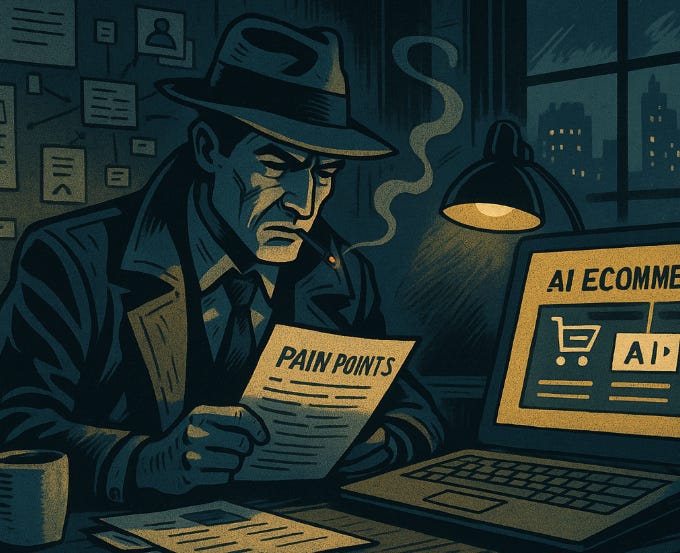Pain Detectives: Why Great Value Propositions Start with Friction
Before you pitch, diagnose. A guide to building AI-era value propositions by thinking like a friction-hunting gumshoe.
Long before a sale is made, long before a feature is demoed or a dashboard is configured - something else kicks off the process.
Pain.
Real marketers, sharp digital merchandisers, and seasoned founders don’t just brainstorm ideas - they investigate. They trace moments of confusion, hesitation, and frustration. They watch replays. They study silence. They look for tension not in trends, but in the patterns people try to work around.
They’re pain detectives.
Value Propositions Start Where the Tension Lives
A strong value proposition doesn’t begin with benefits. It begins with pressure. Real-world, business-crippling, soul-grinding friction.
A team leader swamped with outdated inventory spreadsheets.
A merchandiser guessing which headline will perform, again.
A growth manager losing sleep over why cart abandonment is spiking.
These aren’t just anecdotes. They’re business conditions. If your product or service doesn’t relieve the specific weight of those frustrations, you’re solving problems no one is feeling.
And in ecommerce - especially in 2025 where ai merchandising makes a diagnosis more likely - that difference matters.
Search Engines and Friction: Why This Matters for Visibility
Google’s March 2024 Search Quality Guidelines emphasize "helpful content" over keyword-stuffed fluff. What that really means: content that reflects actual user pain wins.
If your content - and your offer - doesn’t start with the right friction, it won’t just fail to convert. It’ll fail to show up.
That’s where pain detection becomes a visibility tool, not just a messaging trick.
Download Syntheum.ai’s latest Digital Commerce whitepaper:
The Modern Friction Audit
Funnels and bounce rates only get you so far. The modern pain detective looks deeper:
Are users rage-clicking certain elements? (See Hotjar’s report)
Where do drop-offs happen when a feature is “technically working”?
What does a support ticket actually reveal when you read between the lines?
Watch for repetitive actions. Stalled onboarding. Features that should feel obvious but don’t. These aren’t bugs—they’re friction trails.
Don’t immediately fix. First, follow the clues.
From Friction to Framing: How Pain Shapes Messaging
Once you know what someone’s avoiding, you know how to talk to them.
“Tired of uploading spreadsheets every Monday? Automate inventory syncs in two clicks.”
That’s not hype. That’s pain relief.
Marketers who skip this part build content that ranks but doesn’t persuade. Or worse - builds tools no one understands.
The best headlines, landing pages, and ads work because they nail the frustration before pitching a solution. This is especially true in AI-influenced ecommerce, where everyone is touting automation. Clarity, rooted in real-world tension, cuts through that clutter.
AI Will Guess. You Still Have to Know.
AI tools can generate taglines. They can write decent drafts. But they can’t observe the smirk a merchandiser makes when your filter logic doesn’t make sense.
They won’t pick up on how the tone of a client call changes when you say “no setup fees.”
This is where human awareness still matters - and where your advantage lives. The insight doesn’t come from ChatGPT. It comes from knowing what your customer hates repeating.
“AI can automate your workflow, but only you can understand what’s broken in it.”
That’s not anti-tech. It’s pro-relevance.
Don’t Skip the Gut Work: Product-Market Fit Still Begins with Pain
Fast optimization is easy. But real clarity still takes gut work.
Before you A/B test that call-to-action, ask yourself:
What fear does this relieve?
What unpaid labor does it remove?
What embarrassing conversation does it let someone avoid?
If you can’t answer that, go back. You’re not done.
Building Teams That Hunt for Pain
The best teams institutionalize pain detection. They:
Read support tickets weekly.
Watch user sessions.
Join sales calls.
Ask the newest employee what feels clunky.
That’s not just qualitative fluff - it’s how you keep messaging fresh, feature releases useful, and positioning grounded in reality.
As April Dunford says in Obviously Awesome, positioning isn’t what you say. It’s what the market understands. You get that understanding by investigating what people are actually putting up with.
Want to Stay Visible? Start With Friction
Search engines are shifting. User behavior is shifting. But what hasn’t changed is how we decide what matters.
If you want to build messaging that sticks, features that spread, or content that earns real rankings:
Start where the irritation begins.
You don’t need inspiration. You need evidence, Phillip Marlowe. Act accordingly.




